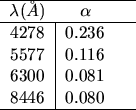
Next: Effective collecting area Up: The Forward model - Previous: Pixel field-of-view Contents
Atmospheric absorption
The emissions studied by ALIS are absorbed mainly in the lower
atmosphere. Further the emission lines observed by ALIS at
![]() Å are all optically thin in the
ionosphere, i.e. photons emitted in the ionosphere are
not absorbed in the region of emission.
Å are all optically thin in the
ionosphere, i.e. photons emitted in the ionosphere are
not absorbed in the region of emission.
The absorption is mainly by
the stratospheric ozone. The amount of absorption depends on the length
of the light path through the stratosphere. The smallest amount of
absorption is obtained for a light path with zero zenith angle. With
increasing zenith angle the light path through the stratosphere
increases as does the absorption. For moderate zenith angles,
![]() , the curvature of the earth can be ignored and with
a zenith optical depth
, the curvature of the earth can be ignored and with
a zenith optical depth
![]() that is dependent on wavelength, the
absorption is:
that is dependent on wavelength, the
absorption is:
The optical depths by Arnoldy and Lewis (1976) that have been used in the current forward model for auroral lines measured by ALIS are given in table 5.1.
Next: Effective collecting area Up: The Forward model - Previous: Pixel field-of-view Contents
copyright Björn Gustavsson 2000-10-24
